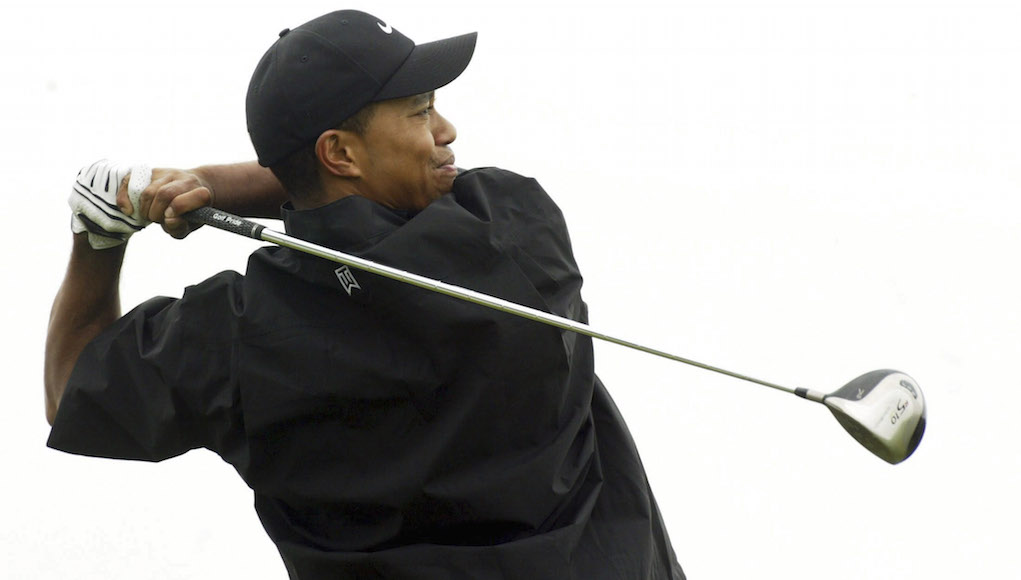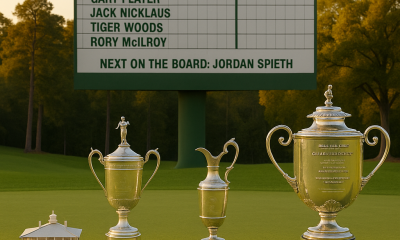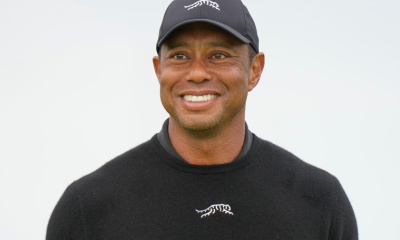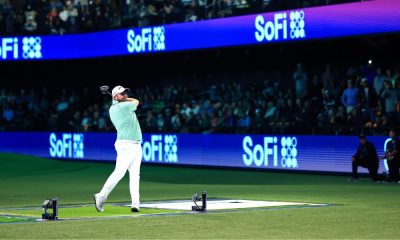Opinion & Analysis
The top-10 biggest equipment changes of Tiger Woods’ career

No golfer’s equipment changes have been followed as closely, or with more scrutiny, than Tiger Woods. For some reason it just matters to us when he makes a change, and it influences the golf equipment world’s buying habits, too.
In his upcoming start in the Hero World Challenge in the Bahamas, Woods is expected to make some major equipment changes. After an extended period away from the game, and with Nike exiting the equipment business, Woods’ final decisions on golf equipment have been a frequent topic of conversation. The video below from a Sunday practice round for the event, however, all but confirms he will be using a TaylorMade M2 driver.
Related: Woods to use a Bridgestone B330S golf ball at the Hero
In honor of his return and expected equipment changes this week, we reminisce on the top-10 biggest equipment changes of Woods’ career.
10) A brief experiment

Woods with a TaylorMade R510 driver in 2003.
If Woods tees it up with a TaylorMade M2 driver at the Hero Challenge, it won’t be the first time he’s put a TaylorMade driver in play in competition. At the 2003 Deutsche Bank SAP Open in Germany, he used a TaylorMade R510 driver (7.5 degrees). Being that it lasted for only that week, it’s certainly one of the most surprising equipment changes Tiger ever made.
9) Swoosh in, Titleist “T” out

Tiger’s Titleist 681T irons, Vokey 200 Series wedges (58 and 60 degrees) and Scotty Cameron Newport 2 GSS putter.
When you think of Tiger in his prime, surely you think of 2000-2001. And here’s a look into his bag during that period. He was bagging Titleist “T” irons (the T stood for Tour, not “Tiger,” which was the cause of much confusion). Woods eventually moved on from the T’s, however, when Nike cooked up these beauties: the Nike Forged Blades.

Woods’ Nike Forged Blade irons.
Ask GolfWRXers what the best blade iron ever made was (join the discussion here), and someone will eventually mention (as easyyy did) the Nike Forged Blades that replaced Tiger’s Titleist irons. He went on to win a slew of majors with the swoosh-stamped irons, using variations of the Nike Forged Blades until he switched to the VR Forged irons in 2009.
Related: The Top-10 Best Nike Equipment Ever Made
8) Tiger drops the Titleist 975D driver

Tiger with a Titleist 975D driver (7.5 degrees) with a True Temper Dynamic Gold steel shaft
Not only was Tiger bagging Titleist irons in 2000-2001, but he also played Titleist’s 975D (7.5 degrees) through his most dominant years. He switched to a Nike driver in 2002, which he used to win the Masters and U.S. Open that year. He returned to the 975D in 2003, searching for more fairways, but like his one-week switch to a TaylorMade driver, it was just a brief experiment.
7) The Victory Reds, made to order

Tiger’s VR Forged irons. He used them during the 2009 and 2010 seasons.
Woods was initially reluctant to switch into the VR (Victory Red) Forged irons from the Nike Forged Blades that he used previously, despite the fact the new VR irons were developed with heavy input from Woods himself. He switched following his 14th major victory (and his left knee surgery), although conspiracy theorists claimed he never actually gamed the retail versions of the irons he designed. That would be a bit odd given they were designed for him, but just add it to the swirling conspiracies regarding Tiger and his golf equipment.
6) Tiger goes to Vapor, sends off Nike
In late 2010, Woods switched from Nike’s VR Forged irons to the company’s VR Pro irons, which are the irons we expect him to use this week at the Hero. He used the VR Pro irons to win five times in 2013, which made his switch to Nike’s Vapor Pro irons in late 2014 all the more shocking.
The Vapor Pro irons used what Nike called a “Modern Muscle Geometry” that moved weight toward the toe of the irons. According to Nike, it centered the sweet spot of the irons to improve performance… and they had a lime green swoosh.

The Nike Vapor Pro irons Woods last used on the PGA Tour.
The Vapor Pro irons were the final blade irons Nike released as a hard goods company, and Tiger never won a golf tournament with them in the bag.
5) A step down from steel

Woods last used Titleist’s 975D driver in 2003.
See all those “steps” in Tiger’s driver shaft in the picture above? He was one of the last professional golfers to switch to a graphite shaft in his driver. The one that stuck was a Mitsubishi Rayon Diamana Blueboard shaft, which is likely the first time you ever heard the Diamana name. We bet it’s not the last you’ve heard of Diamana either, as it remains one of the most popular shafts in golf today.
You can thank Tiger, at least in part, for the popularization of ultra-expensive, after-market graphite shafts.
4) Shaft switch-up

Woods used Graphite Design’s Tour AD-DI 7X shaft from 2010 to 2013.
Remember how we established that Tiger has supreme influence on the golf equipment world? Here’s another example. Before Tiger switched to Graphite Design’s Tour AD-DI 6X shaft in 2010, the company was mostly hanging its hat on the YS-series shafts. Today, the Tour AD series is available in more than a dozen models, and one of the most popular aftermarket shaft lines.
3) The putter before “the putter”

Tiger’s Scotty Cameron Newport 2 GSS putter.
Arguably golf’s most famous putter is Tiger Woods’ Newport 2 GSS Scotty Cameron, which Tiger used to win 13 of his 14 major championships.

Woods used a Scotty Cameron Newport Teryllium TEi3 putter to win the 1997 Masters.
But before that, Tiger employed a Newport Teryllium TEi3 putter from Scotty (a.k.a. “the one with the dots”), which was most notably in his bag to win the 1997 Masters.
2) Tiger tees up the swoosh

Woods’ Nike Tour Accuracy TW golf ball.
Tiger switched from Titleist’s Professional 90 (a wound golf ball) to a Nike Tour Accuracy golf ball in 2000 (a solid-core golf ball), and promptly won his next four majors… no big deal. Then in 2001, Nike released a Nike Tour Accuracy TW (and DD, for “David Duval”), capitalizing on the success of its two biggest stars.
Had he never teed up a Nike golf ball, this moment in sports history would have looked a bit different; and Nike would have been robbed of the ultimate advertisement for a product.
Some believe that Woods’ switch to a solid-core golf ball aided his runaway success in 2000-2001, as most Tour players were still playing wound golf balls at the time (Titleist’s Pro V1 wasn’t released to Tour players until October 2000).
1) The end of an era

Tiger with a Nike Method 001 putter.
After winning nearly every trophy available in the golf world with the Scotty Cameron Newport 2 previously mentioned, Tiger switched a new putter in 2010, the Nike Method 001. Many thought he would never switch, so it was huge news even to casual golf fans.
Tiger hasn’t won a major with the Method, but he did reel off five wins in 2013 to win PGA Player of the Year with it in the bag. Rumor has it, we might see the Scotty back in the bag at the Hero. Does it have any more magic left in it?
Surely we missed something on this list. Let us know your thoughts in the comments section below.
Opinion & Analysis
The 2 primary challenges golf equipment companies face

As the editor-in-chief of this website and an observer of the GolfWRX forums and other online golf equipment discourse for over a decade, I’m pretty well attuned to the grunts and grumbles of a significant portion of the golf equipment purchasing spectrum. And before you accuse me of lording above all in some digital ivory tower, I’d like to offer that I worked at golf courses (public and private) for years prior to picking up my pen, so I’m well-versed in the non-degenerate golf equipment consumers out there. I touched (green)grass (retail)!
Complaints about the ills of and related to the OEMs usually follow some version of: Product cycles are too short for real innovation, tour equipment isn’t the same as retail (which is largely not true, by the way), too much is invested in marketing and not enough in R&D, top staffer X hasn’t even put the new driver in play, so it’s obviously not superior to the previous generation, prices are too high, and on and on.
Without digging into the merits of any of these claims, which I believe are mostly red herrings, I’d like to bring into view of our rangefinder what I believe to be the two primary difficulties golf equipment companies face.
One: As Terry Koehler, back when he was the CEO of Ben Hogan, told me at the time of the Ft Worth irons launch, if you can’t regularly hit the golf ball in a coin-sized area in the middle of the face, there’s not a ton that iron technology can do for you. Now, this is less true now with respect to irons than when he said it, and is less and less true by degrees as the clubs get larger (utilities, fairways, hybrids, drivers), but there remains a great deal of golf equipment truth in that statement. Think about it — which is to say, in TL;DR fashion, get lessons from a qualified instructor who will teach you about the fundamentals of repeatable impact and how the golf swing works, not just offer band-aid fixes. If you can’t repeatably deliver the golf club to the golf ball in something resembling the manner it was designed for, how can you expect to be getting the most out of the club — put another way, the maximum value from your investment?
Similarly, game improvement equipment can only improve your game if you game it. In other words, get fit for the clubs you ought to be playing rather than filling the bag with the ones you wish you could hit or used to be able to hit. Of course, don’t do this if you don’t care about performance and just want to hit a forged blade while playing off an 18 handicap. That’s absolutely fine. There were plenty of members in clubs back in the day playing Hogan Apex or Mizuno MP-32 irons who had no business doing so from a ballstriking standpoint, but they enjoyed their look, feel, and complementary qualities to their Gatsby hats and cashmere sweaters. Do what brings you a measure of joy in this maddening game.
Now, the second issue. This is not a plea for non-conforming equipment; rather, it is a statement of fact. USGA/R&A limits on every facet of golf equipment are detrimental to golf equipment manufacturers. Sure, you know this, but do you think about it as it applies to almost every element of equipment? A 500cc driver would be inherently more forgiving than a 460cc, as one with a COR measurement in excess of 0.83. 50-inch shafts. Box grooves. And on and on.
Would fewer regulations be objectively bad for the game? Would this erode its soul? Fortunately, that’s beside the point of this exercise, which is merely to point out the facts. The fact, in this case, is that equipment restrictions and regulations are the slaughterbench of an abundance of innovation in the golf equipment space. Is this for the best? Well, now I’ve asked the question twice and might as well give a partial response, I guess my answer to that would be, “It depends on what type of golf you’re playing and who you’re playing it with.”
For my part, I don’t mind embarrassing myself with vintage blades and persimmons chasing after the quasi-spiritual elevation of a well-struck shot, but that’s just me. Plenty of folks don’t give a damn if their grooves are conforming. Plenty of folks think the folks in Liberty Corner ought to add a prison to the museum for such offences. And those are just a few of the considerations for the amateur game — which doesn’t get inside the gallery ropes of the pro game…
Different strokes in the game of golf, in my humble opinion.
Anyway, I believe equipment company engineers are genuinely trying to build better equipment year over year. The marketing departments are trying to find ways to make this equipment appeal to the broadest segment of the golf market possible. All of this against (1) the backdrop of — at least for now — firm product cycles. And golfers who, with their ~15 average handicap (men), for the most part, are not striping the golf ball like Tiger in his prime and seem to have less and less time year over year to practice and improve. (2) Regulations that massively restrict what they’re able to do…
That’s the landscape as I see it and the real headwinds for golf equipment companies. No doubt, there’s more I haven’t considered, but I think the previous is a better — and better faith — point of departure when formulating any serious commentary on the golf equipment world than some of the more cynical and conspiratorial takes I hear.
Agree? Disagree? Think I’m worthy of an Adam Hadwin-esque security guard tackle? Let me know in the comments.
@golfoncbs The infamous Adam Hadwin tackle ? #golf #fyp #canada #pgatour #adamhadwin ? Ghibli-style nostalgic waltz – MaSssuguMusic
Podcasts
Fore Love of Golf: Introducing a new club concept

Episode #16 brings us Cliff McKinney. Cliff is the founder of Old Charlie Golf Club, a new club, and concept, to be built in the Florida panhandle. The model is quite interesting and aims to make great, private golf more affordable. We hope you enjoy the show!
Opinion & Analysis
On Scottie Scheffler wondering ‘What’s the point of winning?’

Last week, I came across a reel from BBC Sport on Instagram featuring Scottie Scheffler speaking to the media ahead of The Open at Royal Portrush. In it, he shared that he often wonders what the point is of wanting to win tournaments so badly — especially when he knows, deep down, that it doesn’t lead to a truly fulfilling life.
View this post on Instagram
“Is it great to be able to win tournaments and to accomplish the things I have in the game of golf? Yeah, it brings tears to my eyes just to think about it because I’ve literally worked my entire life to be good at this sport,” Scheffler said. “To have that kind of sense of accomplishment, I think, is a pretty cool feeling. To get to live out your dreams is very special, but at the end of the day, I’m not out here to inspire the next generation of golfers. I’m not out here to inspire someone to be the best player in the world, because what’s the point?”
Ironically — or perhaps perfectly — he went on to win the claret jug.
That question — what’s the point of winning? — cuts straight to the heart of the human journey.
As someone who’s spent over two decades in the trenches of professional golf, and in deep study of the mental, emotional, and spiritual dimensions of the game, I see Scottie’s inner conflict as a sign of soul evolution in motion.
I came to golf late. I wasn’t a junior standout or college All-American. At 27, I left a steady corporate job to see if I could be on the PGA Tour starting as a 14-handicap, average-length hitter. Over the years, my journey has been defined less by trophies and more by the relentless effort to navigate the deeply inequitable and gated system of professional golf — an effort that ultimately turned inward and helped me evolve as both a golfer and a person.
One perspective that helped me make sense of this inner dissonance around competition and our culture’s tendency to overvalue winning is the idea of soul evolution.
The University of Virginia’s Division of Perceptual Studies has done extensive research on reincarnation, and Netflix’s Surviving Death (Episode 6) explores the topic, too. Whether you take it literally or metaphorically, the idea that we’re on a long arc of growth — from beginner to sage elder — offers a profound perspective.
If you accept the premise literally, then terms like “young soul” and “old soul” start to hold meaning. However, even if we set the word “soul” aside, it’s easy to see that different levels of life experience produce different worldviews.
Newer souls — or people in earlier stages of their development — may be curious and kind but still lack discernment or depth. There is a naivety, and they don’t yet question as deeply, tending to see things in black and white, partly because certainty feels safer than confronting the unknown.
As we gain more experience, we begin to experiment. We test limits. We chase extreme external goals — sometimes at the expense of health, relationships, or inner peace — still operating from hunger, ambition, and the fragility of the ego.
It’s a necessary stage, but often a turbulent and unfulfilling one.
David Duval fell off the map after reaching World No. 1. Bubba Watson had his own “Is this it?” moment with his caddie, Ted Scott, after winning the Masters.
In Aaron Rodgers: Enigma, reflecting on his 2011 Super Bowl win, Rodgers said:
“Now I’ve accomplished the only thing that I really, really wanted to do in my life. Now what? I was like, ‘Did I aim at the wrong thing? Did I spend too much time thinking about stuff that ultimately doesn’t give you true happiness?’”
Jim Carrey once said, “I think everybody should get rich and famous and do everything they ever dreamed of so they can see that it’s not the answer.”
Eventually, though, something shifts.
We begin to see in shades of gray. Winning, dominating, accumulating—these pursuits lose their shine. The rewards feel more fleeting. Living in a constant state of fight-or-flight makes us feel alive, yes, but not happy and joyful.
Compassion begins to replace ambition. Love, presence, and gratitude become more fulfilling than status, profits, or trophies. We crave balance over burnout. Collaboration over competition. Meaning over metrics.
Interestingly, if we zoom out, we can apply this same model to nations and cultures. Countries, like people, have a collective “soul stage” made up of the individuals within them.
Take the United States, for example. I’d place it as a mid-level soul: highly competitive and deeply driven, but still learning emotional maturity. Still uncomfortable with nuance. Still believing that more is always better. Despite its global wins, the U.S. currently ranks just 23rd in happiness (as of 2025). You might liken it to a gifted teenager—bold, eager, and ambitious, but angsty and still figuring out how to live well and in balance. As much as a parent wants to protect their child, sometimes the child has to make their own mistakes to truly grow.
So when Scottie Scheffler wonders what the point of winning is, I don’t see someone losing strength.
I see someone evolving.
He’s beginning to look beyond the leaderboard. Beyond metrics of success that carry a lower vibration. And yet, in a poetic twist, Scheffler did go on to win The Open. But that only reinforces the point: even at the pinnacle, the question remains. And if more of us in the golf and sports world — and in U.S. culture at large — started asking similar questions, we might discover that the more meaningful trophy isn’t about accumulating or beating others at all costs.
It’s about awakening and evolving to something more than winning could ever promise.
























Tom
Dec 1, 2016 at 11:29 am
puttin a lot of emphasis on one club…. not the guy using it.
Daniel
Nov 30, 2016 at 1:54 pm
The 983K and 905R were the best ever. I never understood why top level pros move on from Titelist.
Deep Pockets
Dec 14, 2016 at 5:54 pm
$$$
baudi
Nov 30, 2016 at 11:55 am
Don’t forget the very short adventure with the Grafalloy steel tip fairway wood shaft.
And the bent 3 iron (into a 2I) with a Pxi shaft.
Nike Forged Blades – super solid heads indeed. Although I remember Tiger’s model being named the Nike Proto. What I do know is the Tom Stites and Tiger took ±9 months to come the final result.
Gene
Nov 29, 2016 at 11:46 pm
The big omission was his Titleist pro trajectory (PT) 3 wood which he referred to as, “my baby.” Tiger had a bore through shaft in his which was aftermarket? Had a big cult following and Titleist later reissued with bore through shaft. When he switched to graphite shafted driver he said he needed to switch to a 3 wood with a graphite shaft.(Nike, either sq or ignite)
Tony Rich
Nov 29, 2016 at 11:10 pm
Tiger held onto the Vokeys for a while after the 2002 iron switch. It was a year or so later, word was that Vokey
forged those wedges and Tiger waited until he could match the feel and spin he had with the Voke’s. Would love to see some prototype Tiger SM6 blacks in his bag.
Azman Long Hamid
Nov 29, 2016 at 7:25 pm
The influence that he made to the golf industry is astounding, but I bet you he could actually play with any brand of equipment and still get away with it base on talent and skill that he has.
Markallister
Nov 29, 2016 at 5:58 pm
best driver ever: titleist 975j
Uvag
Nov 30, 2016 at 4:27 am
983K
Jdog
Nov 30, 2016 at 6:02 am
Nah, J all the way. Great driver.
Markallister
Nov 30, 2016 at 8:30 am
that was very good also.
Tyler Brown
Nov 29, 2016 at 4:12 pm
That 58 Vokey was bent to 56* with 6* of bounce. The 260.06/260.08 were great grinds from vokey. I think he won the 1997 Masters playing Cleveland 588 TG’s in 56 and 60.
Chunkie Buck
Nov 29, 2016 at 2:04 pm
Ahhhhh…..the 975D! Fond memories! That thing resembles a modern day 5 wood!
Yervag
Nov 29, 2016 at 1:05 pm
Shoes?
Justwellsy
Nov 29, 2016 at 12:55 pm
Great article, really enjoyed this. In my mind, if he regains his confidence with the Cameron back in the bag, everything else will fall into place. He was never an accurate driver of the golf ball and still dominated, so I don’t think he needs that part of his game. Especially since he’ll be nowhere near the top in driving distance these days.
ooffa
Nov 29, 2016 at 11:16 am
Did they all fit in his trunk
carlsheen
Nov 29, 2016 at 10:45 am
love this. The biggest was his putter change leaving the cameron. It was the last to go and for a reason. He was a monster with that cameron.
The Mad Bomber
Nov 30, 2016 at 1:03 am
$$$ is right. That was a shocker.
FSUBASEBALL21
Nov 30, 2016 at 3:01 pm
Everyone knows PXG is making superior equipment. If your not playing PXG’s your at a disadvantage. PERIOD, end of story.